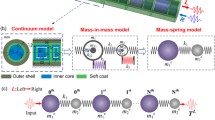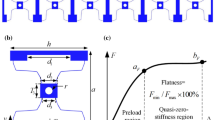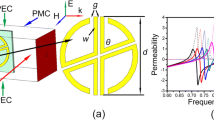Abstract
In this paper, we propose and numerically study a nonlinear, asymmetric, passive metamaterial that achieves giant non-reciprocity with (i) broadband frequency operation and (ii) robust signal integrity. Previous studies have shown that nonlinearity and geometric asymmetry are necessary to break reciprocity passively. Herein, we employ strongly nonlinear coupling, triangle-shaped asymmetric cell topology, and spatial periodicity to break reciprocity with minimal frequency distortion. To investigate the nonlinear band structure of this system, we propose a new representation, namely a wavenumber–frequency–amplitude band structure, where amplitude-dependent dispersion is quantitatively computed and analyzed. Additionally, we observe and document the new nonlinear phenomenon of time-delayed wave transmission, whereby wave propagation in one direction is initially impeded and resumes only after a duration delay. Based on numerical evidence, we construct a nonlinear reduced-order model (ROM) to further study this phenomenon and show that it is caused by energy accumulation, instability, and a transition between distinct branches of certain nonlinear normal modes of the ROM. The implications and possible practical applications of our findings are discussed.










Similar content being viewed by others

References
von Helmholtz, H.: Theorie der Luftschwingungen in Röhren mit offenen Enden. Journal für die reine und angewandte Mathematik 57, 1–72 (1860)
Strutt, J.: Some general theorems relating to vibrations. Proc. Lond. Math. Soc. 1(1), 357–368 (1871)
Casimir, H.B.G.: On Onsager’s principle of microscopic reversibility. Rev. Mod. Phys. 17(2–3), 343 (1945)
Onsager, L.: Reciprocal relations in irreversible processes. I. Phys. Rev. 37(4), 405 (1931)
Cummer, S.A.: Selecting the direction of sound transmission. Science 343(6170), 495–496 (2014)
Fleury, R., Sounas, D., Haberman, M. R., Alu, A.: Nonreciprocal acoustics. Acoustics Today, 11(EPFL-ARTICLE-223074), pp. 14–21 (2015)
Cummer, S.A., Christensen, J., Alù, A.: Controlling sound with acoustic metamaterials. Nat. Rev. Mater. 1(3), 16001 (2016)
Darabi, A., Leamy, M.J.: Clearance-type nonlinear energy sinks for enhancing performance in electroacoustic wave energy harvesting. Nonlinear Dyn. 87(4), 2127–2146 (2017)
Vakakis, A.F., Manevitch, L.I., Mikhlin, Y.V., Pilipchuk, V.N., Zevin, A.A.: Normal Modes and Localization in Nonlinear Systems. Springer, Berlin (2001)
Lu, L., Joannopoulos, J.D., Soljačić, M.: Topological photonics. Nat. Photonics 8(11), 821 (2014)
Khanikaev, A.B., Shvets, G.: Two-dimensional topological photonics. Nat. Photonics 11(12), 763 (2017)
Rechtsman, M.C., Zeuner, J.M., Plotnik, Y., Lumer, Y., Podolsky, D., Dreisow, F., Nolte, S., Segev, M., Szameit, A.: Photonic floquet topological insulators. Nature 496(7444), 196 (2013)
Mahmoud, A.M., Davoyan, A.R., Engheta, N.: All-passive nonreciprocal metastructure. Nat. Commun. 6, 8359 (2015)
Bunyan, J., Moore, K.J., Mojahed, A., Fronk, M.D., Leamy, M., Tawfick, S., Vakakis, A.F.: Acoustic nonreciprocity in a lattice incorporating nonlinearity, asymmetry, and internal scale hierarchy: experimental study. Phys. Rev. E 97(5), 052211 (2018)
Liang, B., Yuan, B., Cheng, J.-C.: Acoustic diode: rectification of acoustic energy flux in one-dimensional systems. Phys. Rev. Lett. 103(10), 104301 (2009)
Liang, B., Guo, X., Tu, J., Zhang, D., Cheng, J.: An acoustic rectifier. Nat. Mater. 9(12), 989 (2010)
Nassar, H., Xu, X., Norris, A., Huang, G.: Modulated phononic crystals: non-reciprocal wave propagation and Willis materials. J. Mech. Phys. Solids 101, 10–29 (2017)
Adam, J.D., Davis, L.E., Dionne, G.F., Schloemann, E.F., Stitzer, S.N.: Ferrite devices and materials. IEEE Trans. Microw. Theory Techn. 50(3), 721–737 (2002)
Sounas, D.L., Soric, J., Alu, A.: Broadband passive isolators based on coupled nonlinear resonances. Nat. Electron. 1(2), 113 (2018)
Sounas, D.L., Alú, A.: Time-reversal symmetry bounds on the electromagnetic response of asymmetric structures. Phys. Rev. Lett. 118(15), 154302 (2017)
Sounas, D.L., Caloz, C., Alu, A.: Giant non-reciprocity at the subwavelength scale using angular momentum-biased metamaterials. Nat. Commun. 4, 2407 (2013)
Fleury, R., Sounas, D., Alu, A.: An invisible acoustic sensor based on parity-time symmetry. Nat. Commun. 6, 5905 (2015)
Fleury, R., Sounas, D.L., Sieck, C.F., Haberman, M.R., Alù, A.: Sound isolation and giant linear nonreciprocity in a compact acoustic circulator. Science 343(6170), 516–519 (2014)
Devaux, T., Cebrecos, A., Richoux, O., Pagneux, V., Tournat, V.: Acoustic radiation pressure for nonreciprocal transmission and switch effects. Nat. Commun. 10(1), 3292 (2019)
Estep, N.A., Sounas, D.L., Soric, J., Alù, A.: Magnetic-free non-reciprocity and isolation based on parametrically modulated coupled-resonator loops. Nat. Phys. 10(12), 923 (2014)
Kamal, A., Clarke, J., Devoret, M.: Noiseless non-reciprocity in a parametric active device. Nat. Phys. 7(4), 311 (2011)
Trainiti, G., Ruzzene, M.: Non-reciprocal elastic wave propagation in spatiotemporal periodic structures. New J. Phys. 18(8), 083047 (2016)
Chen, Y., Li, X., Nassar, H., Norris, A.N., Daraio, C., Huang, G.: Nonreciprocal wave propagation in a continuum-based metamaterial with space-time modulated resonators. Phys. Rev. Appl. 11(6), 064052 (2019)
Li, J., Shen, C., Zhu, X., Xie, Y., Cummer, S.A.: Nonreciprocal sound propagation in space-time modulated media. Phys. Rev. B 99(14), 144311 (2019)
Moore, K.J., Bunyan, J., Tawfick, S., Gendelman, O.V., Li, S., Leamy, M., Vakakis, A.F.: Nonreciprocity in the dynamics of coupled oscillators with nonlinearity, asymmetry, and scale hierarchy. Phys. Rev. E 97(1), 012219 (2018)
Fronk, M. D., Tawfick, S., Daraio, C., Vakakis, A. F., Leamy, M. J.: Non-reciprocity in structures with nonlinear internal hierarchy and asymmetry. In: Proceedings of the ASME 2017 international design engineering technical conferences and computers and information in engineering conference. American Society of Mechanical Engineers, pp. V008T012A023–V008T012A023
Wu, Z., Zheng, Y., Wang, K.: Metastable modular metastructures for on-demand reconfiguration of band structures and nonreciprocal wave propagation. Phys. Rev. E 97(2), 022209 (2018)
Boechler, N., Theocharis, G., Daraio, C.: Bifurcation-based acoustic switching and rectification. Nat. Mater. 10(9), 665 (2011)
Wu, Z., Wang, K.-W.: On the wave propagation analysis and supratransmission prediction of a metastable modular metastructure for adaptive non-reciprocal energy transmission, arXiv preprint arXiv:1709.03229
Gu, Z.-M., Hu, J., Liang, B., Zou, X.-Y., Cheng, J.-C.: Broadband non-reciprocal transmission of sound with invariant frequency. Sci. Rep. 6, 19824 (2016)
Popa, B.-I., Cummer, S.A.: Non-reciprocal and highly nonlinear active acoustic metamaterials. Nat. Commun. 5, 3398 (2014)
Darabi, A., Fang, L., Mojahed, A., Fronk, M.D., Vakakis, A.F., Leamy, M.J.: Broadband passive nonlinear acoustic diode. Phys. Rev. B 99(21), 214305 (2019)
Li, N., Ren, J.: Non-reciprocal geometric wave diode by engineering asymmetric shapes of nonlinear materials. Sci. Rep. 4, 6228 (2014)
Hussein, M.I., Leamy, M.J., Ruzzene, M.: Dynamics of phononic materials and structures: historical origins, recent progress, and future outlook. Appl. Mech. Rev. 66(4), 040802 (2014)
Narisetti, R.K., Leamy, M.J., Ruzzene, M.: A perturbation approach for predicting wave propagation in one-dimensional nonlinear periodic structures. J. Vib. Acoust. 132(3), 031001 (2010)
Blanchard, A., Sapsis, T.P., Vakakis, A.F.: Non-reciprocity in nonlinear elastodynamics. J. Sound Vib. 412, 326–335 (2018)
Shaw, S., Pierre, C.: Non-linear normal modes and invariant manifolds. J. Sound Vib. 150(1), 170–173 (1991)
Kerschen, G., Peeters, M., Golinval, J.-C., Vakakis, A.F.: Nonlinear normal modes, part I: a useful framework for the structural dynamicist. Mech. Syst. Signal Process. 23(1), 170–194 (2009)
Peeters, M., Viguié, R., Sérandour, G., Kerschen, G., Golinval, J.-C.: Nonlinear normal modes, part II: toward a practical computation using numerical continuation techniques. Mech. Syst. Signal Process. 23(1), 195–216 (2009)
Acknowledgements
The authors would like to thank the National Science Foundation for supporting in part this research under the Emerging Frontiers in Research and Innovation (EFRI) Grant No. 1741565.
Author information
Authors and Affiliations
Corresponding author
Ethics declarations
Conflict of interest
The authors declare that they have no conflict of interest.
Additional information
Publisher's Note
Springer Nature remains neutral with regard to jurisdictional claims in published maps and institutional affiliations.
Appendix
Appendix
- I.:
Linear dispersion analysis
The dispersion relationship of a linear periodic structure can be pursued by solving the eigenvalue problem of the equations of motion with Bloch boundary conditions [39]. Here, we reconsider Eq. 2 with a detailed study as follows,
where M and \(K(\mu )\) are mass and stiffness matrix, respectively, and \(\mu \) denotes the wavenumber. Without loss of generality, we express the non-trivial displacement vector as \(\tilde{\hbox {u}}\left( \mu \right) e^{in\mu }\), where n denotes the unit cell of interest. The mass matrix contains diagonal entries corresponding to the individual masses, and the stiffness matrix \(K(\mu )\) is computed from,
where \(m=-1,\, 0,+1\) represents three adjacent unit cells: \(n-1,\, n\), and \(n+1\), and \(k_{m}\) denotes the conventional stiffness matrix describing the spring interaction within the representative unit cell and with its neighbors. The term \({e}^{im\mu }\) further modifies the stiffness matrix with Bloch boundary conditions. Thus, by sweeping the wavenumber from 0 to \(\pi \) and solving the eigenvalue problem in term of \(\omega ^{2}\), we obtain the linear dispersion relationship in the first Brillion zone.
- II.:
Dispersion curve fitting
In numerical simulations, for each input amplitude, we sweep the frequency of the harmonic input from 0 to 22 rad/s, with an increment of 0.1 rad/s. Propagation constants are then measured from each corresponding response. The scatter points are displayed on the frequency–wavenumber plane, and a curve fit is conducted as follows:
- (a):
The noise points are recognized based on their dominant frequency (i.e., if the dominant frequency over the selected duration of response is not the sending frequency, the transmitted signal is considered as noise).
- (b):
Branches (in our case, only the acoustic and the first optical branches) are recognized manually. Different dispersion curves are curve-fitted individually.
- (c):
A 9-degree polynomial curve fit (“poly9” in MATLAB) is selected as the main fit function.
- (d):
For the acoustic branch, to ensure a zero-group-velocity condition at \(\, \mu =\pi \), we let \(x=\mathrm {sin}(\frac{\mu }{2})\), and \(y={\upomega }\), and we then find the curve fit coefficients.
- (e):
For the first optical branch, to ensure zero-group velocity condition at \(\mu =0,\, \pi \), we let \(x=\mathrm {cos}(\mu )\), and \(y={\upomega }\), and then find the curve fit coefficients.
An example scatter-point diagram with the corresponding curve fit result is shown in Fig. 11.
- III.:
Nonlinear normal modes
For an n degree of freedom Hamiltonian system, there are two fundamental theorems by Lyapunov and Weinstein, which indicate n distinct periodic solution(s) near each stable equilibrium at fixed energy level. These solutions are called nonlinear normal modes (NNMs) and can be related to the classic linear vibration modes [36]. By sweeping the energy and solving the equations of motion (see below), we are able to describe the mode frequency and the corresponding mode shape as a function of energy. The resultant NNM result is revealed in Fig. 12.
In the low energy regime (near \({10}^{-8}\) J), the frequencies of the nonlinear modes are 23.06 rad/s and 35.08 rad/s, respectively, which is close to the linear natural frequencies of the model. As energy grows, the frequency increases, and Mode 1 experiences a bifurcation at the energy level of approximately \({10}^{-5}\) J.
For further investigation and easier comparison with the full-order model, we replace the horizontal axis of the NNM result from energy to relative displacement between masses 6 and 7, illustrated in Fig. 8a. The modification is motivated by the continuous excitation of the system, which makes it challenging to capture the fluctuating energy and conduct further comparison.
Rights and permissions
About this article
Cite this article
Fang, L., Darabi, A., Mojahed, A. et al. Broadband non-reciprocity with robust signal integrity in a triangle-shaped nonlinear 1D metamaterial. Nonlinear Dyn 100, 1–13 (2020). https://doi.org/10.1007/s11071-020-05520-x
Received:
Accepted:
Published:
Issue Date:
DOI: https://doi.org/10.1007/s11071-020-05520-x





